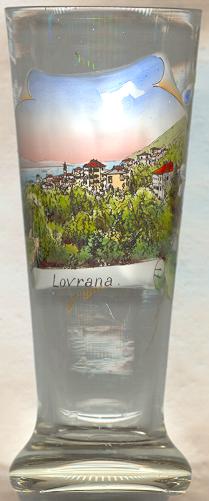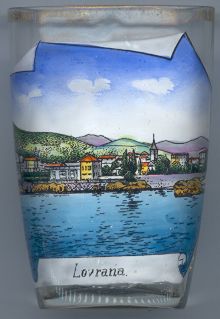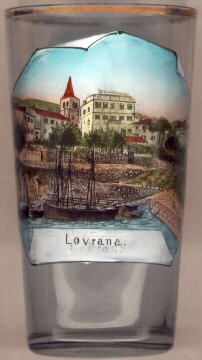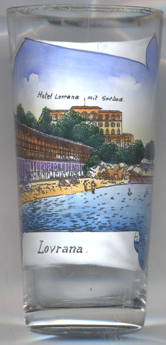

|
| HRVATSKA | CROATIA |
| županija: Primorsko-goranska |

 Lovran was first mentioned in the 7th century as Lauriana.
The name is derived from the Latin name for laurel, laurus.
Between the 9th and the 10th century it belonged to the Croatian kingdom.
Later it was ruled by the patriarchs of Aquilea and the Counts of Pazin.
In the14th century it became part of the Habsburg countries.
The development of Lovran as a summer resort began in the19th century
together with the growing popularity of Opatija.
Lovran was first mentioned in the 7th century as Lauriana.
The name is derived from the Latin name for laurel, laurus.
Between the 9th and the 10th century it belonged to the Croatian kingdom.
Later it was ruled by the patriarchs of Aquilea and the Counts of Pazin.
In the14th century it became part of the Habsburg countries.
The development of Lovran as a summer resort began in the19th century
together with the growing popularity of Opatija.
 The centre of the old town is marked by the
The centre of the old town is marked by the
 parish church of Sveti Juraj (St. George)
[near left, no. 068: background left],
built in the 14th century. The church was enlarged several times in the 16th and 17th century.
The vaulting from the late Gothic period is decorated with important
frescos from the15th century showing scenes from the life and passion of Christ.
The campanile (bell-tower) is older than the church itself, it dates from the 12th century.
parish church of Sveti Juraj (St. George)
[near left, no. 068: background left],
built in the 14th century. The church was enlarged several times in the 16th and 17th century.
The vaulting from the late Gothic period is decorated with important
frescos from the15th century showing scenes from the life and passion of Christ.
The campanile (bell-tower) is older than the church itself, it dates from the 12th century.
 Glass no. 3499 [near left] is labeled (in German)
Hotel Lovrana mit Seebad.
('Hotel Lovrana with seaside baths').
Glass no. 3499 [near left] is labeled (in German)
Hotel Lovrana mit Seebad.
('Hotel Lovrana with seaside baths').
The  Grand Hotel Lovrana (or Laureana) was built in 1903/1909 as a luxury hotel for the
aristocracy of that time. In 1935, it was converted to become a health institution. During World War II, it was
converted into a military hospital, which remained until 1953, when it became a civilian property for the purpose of
primarily treating bone and joint tuberculosis. With the reduction of tuberculosis frequency the hospital
it it became a general orthopedic hospital. With the foundation in 1956 of the Faculty of Medicine of the university
of Rijeka, it also became a teaching institution for the education of medical students.
In 1976 it was awarded the status of a clinical hospital and today is named the Orthopaedic Clinic of Lovran.
Grand Hotel Lovrana (or Laureana) was built in 1903/1909 as a luxury hotel for the
aristocracy of that time. In 1935, it was converted to become a health institution. During World War II, it was
converted into a military hospital, which remained until 1953, when it became a civilian property for the purpose of
primarily treating bone and joint tuberculosis. With the reduction of tuberculosis frequency the hospital
it it became a general orthopedic hospital. With the foundation in 1956 of the Faculty of Medicine of the university
of Rijeka, it also became a teaching institution for the education of medical students.
In 1976 it was awarded the status of a clinical hospital and today is named the Orthopaedic Clinic of Lovran.
[http://orto-lovran.hr/povijest.html, http://ineco.posluh.hr/pgz/lovran/evile.htm]
![[scale]](lineal.jpg)